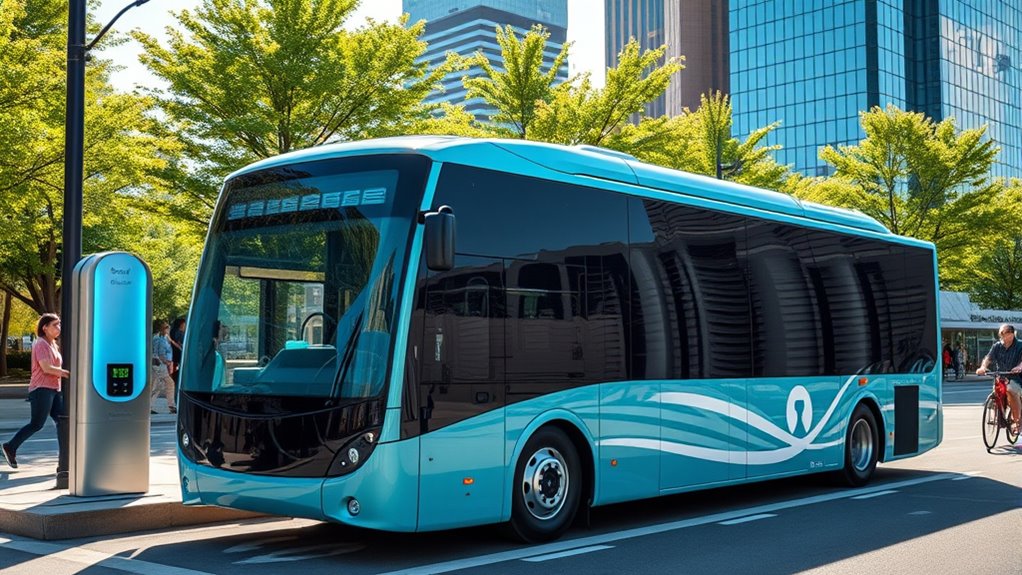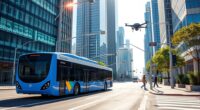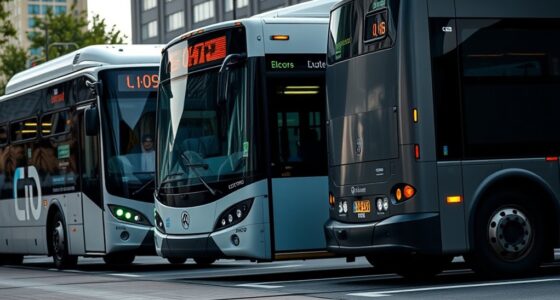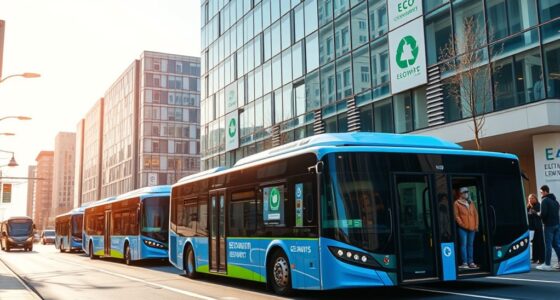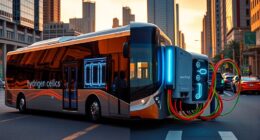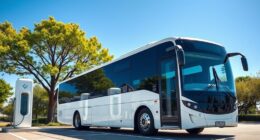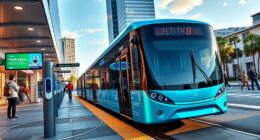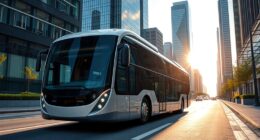Electric buses help reduce greenhouse gas emissions by converting up to 100% of grid energy into motion, making them more energy-efficient than traditional diesel or propane buses. They produce fewer emissions over their lifespan, especially as electricity grids become cleaner with more renewables. This means cleaner air, healthier communities, and long-term savings. If you want to discover how switching to electric buses impacts climate and air quality, there’s more to explore.
Key Takeaways
- Electric buses convert up to 100% of grid energy into motion, reducing energy waste and emissions compared to traditional engines.
- Using renewable energy sources for charging can cut greenhouse gas emissions by up to 96%.
- They produce fewer emissions over their lifespan, especially as electricity grids become cleaner.
- Electric buses eliminate diesel exhaust and particulates, improving air quality and lowering health-related emissions.
- Transitioning to electric buses significantly decreases overall greenhouse gas emissions, saving over 2 million tons annually in the U.S.

Have you ever wondered how electric buses can help reduce greenhouse gas emissions? The answer lies in their impressive energy conversion efficiency. Unlike internal combustion engines that waste a significant portion of fuel as heat, electric buses convert between 77% and 100% of the energy they receive from the grid into motion. This higher efficiency means they use less energy overall, leading to fewer emissions per mile traveled.
Electric buses convert up to 100% of grid energy into motion, drastically reducing emissions per mile.
Additionally, electric buses have a lower lifecycle greenhouse gas footprint compared to diesel and propane buses. When you consider the entire lifespan—from manufacturing to disposal—they emit substantially less greenhouse gases, especially as the electricity powering them becomes cleaner. Incorporating renewable energy sources into electricity generation further enhances these benefits, making electric buses an even more sustainable choice.
Your region’s electricity generation source plays an essential role in how much electric buses can cut emissions. If your area’s grid relies heavily on coal or natural gas, the emissions reduction might be less pronounced than in regions powered by renewables. However, as the electric grid transitions toward more renewable energy sources, the emissions associated with charging electric buses will decrease even further.
Furthermore, the environmental benefits are amplified when considering energy efficiency, which allows electric buses to do more with less energy compared to traditional models.
This shift makes electric buses a future-proof choice, as their operational emissions will continue to decline over time. The beauty is that electric buses’ emissions aren’t fixed; they adapt as the grid gets greener, unlike diesel buses that emit a consistent level of pollutants regardless of external factors.
Compared to traditional buses, electric models offer remarkable reductions in greenhouse gases. When powered by renewable energy, electric buses can slash emissions by up to 96% relative to diesel buses. Even in regions with high coal or gas use, electric buses still produce fewer emissions than propane-powered buses.
Replacing diesel transit buses with electric ones could eliminate over 2 million tons of greenhouse gases annually just in the U.S. Plus, electric buses are about 70% more energy efficient than diesel models, meaning they do more with less energy—saving both the environment and your operating costs.
Beyond reducing greenhouse gases, electric buses notably improve air quality. They eliminate diesel exhaust and particulate pollution, which are major contributors to ground-level ozone and smog formation. Cleaner air benefits your community’s health, reducing adult mortality and childhood asthma rates.
Especially in urban areas with high pollution levels, electric buses help create healthier environments for everyone. Better air quality translates into fewer health issues and lower medical costs, making electric buses not only a climate solution but a public health boon.
Incorporating organic farming methods into the production of components for electric buses can further reduce their overall environmental impact. Economically, electric buses offer long-term savings. They’ve lower maintenance costs because their electric motors are simpler and more durable than traditional engines. Plus, in regions with favorable utility policies, electric buses can reduce fuel expenses substantially.
Each electric bus can deliver up to $247,600 in combined climate and health benefits over its lifetime. These savings make electric buses a smart investment, providing both financial and environmental returns. As technology advances, their efficiency and affordability will only improve, making them an increasingly indispensable tool in the fight against climate change.
Frequently Asked Questions
How Long Do Electric Bus Batteries Typically Last?
You might wonder how long electric bus batteries last. Typically, these batteries last between 5 to 7 years.
But advanced technologies like CATL’s Tectrans can extend lifespan up to 15 years.
Factors like charging habits, temperature, and usage affect durability.
When batteries reach the end of their life, they can be recycled or repurposed for energy storage, ensuring maximum value and sustainability over time.
What Is the Initial Cost of Electric Buses Compared to Diesel Buses?
The initial cost of electric buses is around $352,000, which is much higher than diesel buses, typically costing less than $100,000. This higher price mainly comes from expensive batteries.
However, you can offset these costs with grants and incentives.
Over time, electric buses save you money on fuel and maintenance, making them a smarter investment in the long run, despite the higher upfront expense.
How Do Electric Buses Perform in Extreme Weather Conditions?
Imagine facing winter’s grip or summer’s heat—your electric bus handles it better than you’d think. Its weight distribution improves traction in snow, and design features boost stability.
Cold reduces range by up to 30%, but with proper planning, you can navigate weather challenges.
Hot weather affects battery performance, yet advances in insulation and cooling help maintain efficiency.
What Are the Charging Infrastructure Requirements for Electric Buses?
You need to plan your charging infrastructure carefully for electric buses. High-capacity facilities require significant power, sometimes over 50 MW, with multiple charging stations for overnight charging.
On-route charging systems, like pantograph or inductive chargers, need to be integrated along routes.
Also, verify your grid can handle the demand, which may be equivalent to tens of thousands of homes, and consider costs for upgrades and maintenance.
Are There Government Incentives for Adopting Electric Bus Fleets?
You won’t believe the power of government incentives to transform your shift to electric buses! These incentives include hefty grants, tax credits, and subsidies that lower your upfront costs.
Plus, they support charging infrastructure and offer financial assistance. With these programs, you can save money, create jobs, and promote sustainable transit.
Applying for funding is straightforward, and your project can align with environmental goals, making a real difference in your community.
Conclusion
By choosing electric buses, you play a crucial role in cutting greenhouse gas emissions. Did you know that electric buses produce up to 75% fewer emissions than traditional diesel buses? That means your daily commute can considerably reduce your carbon footprint. As more cities adopt electric buses, the air gets cleaner, and the planet benefits. So, next time you see one on the road, remember—you’re part of the movement toward a greener, healthier future.
